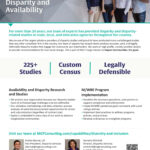Fred Seamon, PhD, MGT Alumnus and Former Executive Vice President
I am a native Floridian who grew up in Orlando during the era of segregation and the civil rights movement in the 1960s. I went to segregated public schools and attended Bethune-Cookman University, a Historically Black College and University (HBCU) in Daytona Beach.
In the last semester of my senior year of college in 1970, I did an internship with the Florida Parole and Probation Commission and saw first-hand racial disparities in the criminal justice system of Volusia County, Florida.
To see the differences in processing and sentencing between white and people of color was a stark reality. Often a person of color who committed a crime was sentenced to 10 to 20 years more than a white person who was convicted of the same crime.
After I graduated college, my first position was as a Probation Counselor with the Volusia County Juvenile Court. There, again, I witnessed the disparities in the juvenile court system. It was not unusual for white kids who were arrested or detained for infractions to have the police call their mothers and fathers to pick them up. Black kids were typically sent to detention centers. The differences in treatment were glaring.
After two years with the Volusia County Juvenile Court, my boss recommended that I attend Florida State University (FSU) to work on a master’s degree in social work (MSW). That is what brought me to Tallahassee. I was only going to stay in Tallahassee to get my MSW and then go back to Daytona Beach and get my old job back in Volusia County.
In 1971, at FSU, there were few Black students on campus and even fewer professors or staff of color. It was quite noticeable.
As a student member of the minority affairs committee, I focused on increasing the recruitment and diversity of students in the master’s social work program. After completing my MSW, I decided to get a PhD in higher education and administration at FSU. In all the courses I took, there were probably no more than one or two PhD students of color.
For my dissertation, I focused on desegregation in higher education that was spurred by the historic Adams v. Richardson U.S. District Court, DC, decision in 1972. The National Association for the Advancement of Colored People (NAACP) had sued the federal Department of Health, Education and Welfare (HEW) for allowing states to continue to receive federal funds in violation of Title VI of the Civil Rights Act of 1964.
Title VI states that:
No person in the United States shall, on the grounds of race, color, or national origin, be excluded from participation in, be denied the benefits of, or be subjected to discrimination under any program or activity receiving Federal financial assistance.
The court ruled in favor of the NAACP in Adams v. Richardson by requiring HEW to develop tougher standards for North Carolina and nine other states that did not have a desegregation plan for higher education.
Fundamentally, the Adams vs. Richardson case focused on dismantling the dual systems of higher education across the country. I looked at that court decision as a pathway to help desegregate schools for equitable learning opportunities.
As I was finishing my PhD in higher education administration, FSU offered me a position in the School of Social Work. I taught courses related to social work with minority and underserved individuals and families. I also headed up the minority affairs office for the School of Social Work.
Joining forces with MGT
Fast forwarding a few years, I received a call from a friend who was working with MGT, which was then headquartered in Tallahassee. He wanted me to speak with MGT’s CEO about a project that the firm was doing.
The initial MGT project involved The State of Florida and a class action suit related to the horrific treatment of people with disabilities. Disabled people were being warehoused in large institutions in Florida called Sunland Centers. The institutions housed people in what they called “crib cages,” where residents never saw the light of day. Because of this class action suit, the State of Florida shut down the Sunland Centers and relocated people with disabilities into community-based field facilities. MGT had a contract with one of the private vendors that was going to be opening new care facilities in the state.
I agreed to train and supervise staff that came from the Sunland Centers to operate community cluster homes. I took a leave of absence from FSU to do the project.
As the first project was winding down, MGT asked if I would conduct training at another facility. After that second facility, MGT was awarded a significant contract with the Oklahoma Department of Human Services, the largest contract MGT had at the time. MGT asked if I would head one of the project teams. I agreed to do so, which led to a nine-year engagement with MGT.
When I went back to FSU, I was on an as-needed contract with MGT for consulting projects and teaching full-time in the Askew School of Public Administration and Public Policy, as well as the Pepper Institute on Aging. In both places, I conducted research for local and state government agencies in Florida to identify and address the disparities related to employment, compensation, workforce development, and contracting in minority populations.
MGT offered me a partnership in the firm in 1998, and I have worked on numerous disparity studies throughout the country ever since. I officially retired from MGT on December 31, 2021, and recently completed the last of several long-term client projects.












